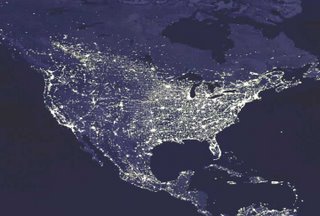A car traveling at 80 km/h (50mph) uses half its fuel to overcome wind resistance.
Knowledge is growing so fast that ninety per cent of what we will know in fifty years time, will be discovered in those fifty years. (This one’s almost scary!)
Ten minutes of one hurricane contains enough energy to match the nuclear stockpiles of the world.

When hydrogen burns in the air, water is formed.
It is energy-efficient to turn off a fluorescent light only if it will not be used again within an hour or more. This is because of the high voltage needed to turn it on, and the shortened life this high voltage causes.

Due to gravitational effects, you weigh slightly less when the moon is directly overhead.
The Earth's average velocity orbiting the sun is 107,220 km per hour (66,623mph).
The United States consumes 25% of all the world’s energy.

A Boeing 707 uses four thousand gallons of fuel in its take-off climb.
It takes 70% less energy to produce a ton of paper from recycled paper than from trees.
Every year in the US, 625 people are struck by lightning.
A bolt of lightning is about 54,000°F (30,000°C); six times hotter than the Sun.

The temperature can be determined by counting the number of cricket chirps in fourteen seconds and adding 40. (This is unbelievable! I’m definitely going to be trying this!)
Our eyes are always the same size from birth, but our nose and ears never stop growing.

The human brain is 80% water.
As an adult, you have more than 20 square feet of skin on your body--about the same square footage as a blanket for a queen-sized bed.
In your lifetime, you'll shed over 40 pounds of skin.
15 million blood cells are produced and destroyed in the human body every second.
The brain uses more than 25% of the oxygen used by the human body.
There are more living organisms on the skin of a single human being than there are human beings on the surface of the earth. (That’s kind of creepy.)
A cockroach can live for several weeks without its head.
Rats multiply so quickly that in 18 months, two rats could have over 1 million descendents.



10 comments:
Interesting post! Lots of cool facts.
"Rats multiply so quickly that in 18 months, two rats could have over 1 million descendents."
I'm a fairly peaceful guy, but when I see a rat or a mouse, I have a sudden urge to inflict pain on it. Maybe its because a hamster bit me during my first year at school and that early experience caused this hatred :) Most other "pests" (such as snakes, spiders, ant, etc.) don't bother me a bit, but I can't stand uninvited rodent presence.
Rats are actually fascinating. I think based on surival characteristics alone, rats can do far better in "surival of the fitest" than humans. They are basically surivival machines. In so many ways they are better at staying alive collectively than humans are. They eat just about anything. They breed quickly and plentifully. They can survive just about anything. They live almost anywhere. They can swim well and can stay underwater long. They've even succeed into tricking some humans by leading them to believe that they are their relatives. And, whats more shrewd: some of them have tricked humans into keeping them in fancy cages and reguarly feeding them. :) :) :)
Eeeewwww.
I have a Luke (3 years).
Thanks for the trivia. Interesting. Kind of grose, but interesting! : )
Ashley: I'll be sure to let you know. :)
Mark: I would say, in the event of a nuclear war, it would end up being cockroaches vs. rats for ultimate survival
Gina: "Luke's" a good name.
Just go back and read some of the first one's over instead of ending on rats. Maybe then they won't seem so gross. :)
now I know when to weigh! lol
and how do airlines make any money burning that much fuel at take off? amazing!
thanks for sharing!
When 2 molecules of hydrogen combust with one molecule of oxygen, water is formed.
Therefore,
when 2 molecules of hydrogen(limiting factor) combine with 1 molecule of oxygen in the atmostsphere, water is formed. That is also known as rain, snow, sleet, hail, fog, and humidity.
The hydrogen is the limiting factor in this equation, becuase the atmosphere is 23% Oxygen and less than 2 % hydrogen.
See Mom, I know my chem.
Smart IA that is homeschooled
Smart IA that is homeschooled: Are you sure that Hydrogen combining with Oxygen is where we get rain, snow, sleet, hail, fog, and humidity? I mean, I know that all those are H20 in some form, but I don't think they actually form from the individual gasses while in our atmosphere and then fall to earth.
It was my understanding that they already exist as liquid on the earth before being evaporated into the atmosphere where, due to different forces of nature, they are converted into one of those forms of precipitation.
Well, when water is formed in the atmosphere, it has to go somewhere, so it condenses in to a cloud formation. Generally, you will then experience some sort of precipitation. Just depends on the temperature of the climate whether it is rain, snow, sleet, hail, fog, or humidity.
If that doesn't happen, where does the water go after being formed in the atmosphere?
My point was DUH.. oxygen and hydrogen do form water. That can take place almost anywhere on earth(atmosphere, your kitchen cabinet, the front seat of your vehicle)where there is sufficient hydrogen and oxygen supplies and the conditions are the proper pressure and temperature.
anonymous: "There are a number of atmospheric gases which make up air. The main gases are nitrogen and oxygen, which make up 78% and 21% of the volume of air respectively. Oxygen is utilised primarily by animals, including humans, but also to a small degree by plants, in the process of respiration (the metabolism of food products to generate energy).
The remaining 1% of the atmospheric gases is made up of trace gases. These include the noble gases, very inert or unreactive gases, of which the most abundant is argon. Other noble gases include neon, helium, krypton and xenon. Hydrogen is also present in trace quantities in the atmosphere, but because it is so light, over time much of it has escaped Earth's gravitational pull to space.
The remaining trace gases include the greenhouse gases, carbon dioxide, methane, nitrous oxide, water vapour and ozone, so-called because they are involved in the Earth natural greenhouse effect which keeps the planet warmer than it would be without an atmosphere.
My only point was that the amount of precipitation from Hydrogen bonding with Oxygen in our atmosphere is miniscule to the point of being negligible. The actually amount of Hydrogen in our atmosphere is 0.00005%. So, while you were technically correct by saying "less than 2%" it was slightly misleading.
sorry
No apology needed. I got to learn some new stuff as a result of checking out your facts. *grin*
Thanks.
Post a Comment